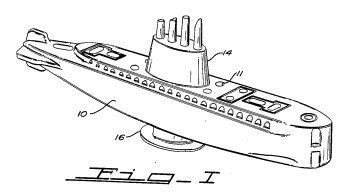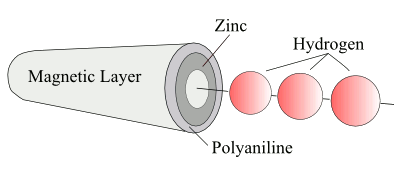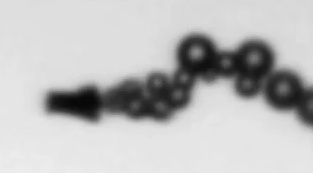Bubble Rockets
February 13, 2012
When I was a
child,
marketing was much different from what's practiced today. When you filled your
automobile fuel tank with
gasoline, you got the gasoline that you paid for (at $0.199/gallon), and also a free piece of
glassware; or a
volume of an
encyclopedia. When a
housewife bought
laundry detergent, it was a huge box filled with
phosphate powder and a bonus
wash cloth or dish towel.
These phosphate detergents had another application, as I learned from a
boy's magazine. The instructions were to nail a
soup can on the end of a wooden pole, and then fill it with a
water solution of the detergent. When you gently raised the can below a
housefly on the
ceiling, the fly would be overcome by
fumes and drop into the can. I wonder where that entry would be on the
material safety data sheet.
As if the
sugar-laden breakfast cereal wasn't treat enough for a child, boxes of breakfast cereal also contained a
toy. One such toy, which had the additional benefit to
mothers of encouraging their
ragamuffins to bathe, was a
baking powder submarine. In those days before the
Internet, or even
color television, it was one of the few ways for children to have fun inside a house.

Figure one of US Patent No. 2,712,710, "Toy Submarine," by Henry Hirsch and Benjamin L. Hirsch, July 12, 1955.
(Via Google Patents)[1]
This
patented idea [1] is based on the reaction of the cooking ingredient,
baking powder, with water. Baking powder acts as a
leavening agent by creating carbon dioxide bubbles that decrease the density of cakes to make them "lighter." It's typically a mixture of baking soda (
sodium bicarbonate, NaHCO
3) and an
acid salt in a
starch base. The starch is there to prevent too fast a
reaction. The reaction is simply given as
NaHCO3 + H+ -> Na+ + CO2 + H2O
Because of its
weight, the
submarine will initially sink in a tub of water. As the baking powder reacts, it generates
carbon dioxide gas that raises the submarine to the surface. At the surface, the carbon dioxide is expelled, and the submarine sinks for another cycle. At least, that's the theory, but additional cycles were infrequently realized in my own bathtub. Perhaps that's why I went into
physics, and not
chemistry.
The submarine was popular, primarily because of the publicity surrounding the
USS Nautilus, the first
nuclear-powered submarine. The
inventors followed up with a diving
frogman that wasn't as much fun.[2-3]
I was reminded of these toys when I read about research at the
Department of Nanoengineering of the
University of California, San Diego. A research team led by
Joseph Wang, a Professor of Nanoengineering, has been investigating
bubble-powered
microrockets powered by reactions between
zinc and
acid media.[4-7] Since these acid media are present in the human body, this invention may have
medical applications.

Schematic of a bubble microrocket.
(Illustration by author, rendered with Inkscape)
The basic microrocket, as shown in the figure, consists of a
conical polyaniline tubular shell that's
electroplated with zinc on the interior, and a
magnetic alloy on the exterior.[4] The magnetic layer allows the microrocket's
trajectory to be directed by external
magnetic fields. The zinc is the fuel that produces
hydrogen gas when placed in an acid medium. The basic reaction is as follows:
Zn + 2H+ -> Zn2+ + H2
Of course, there would be a companion reaction with the zinc
cation of the form
Zn2+ + 2Cl- -> ZnCl2,
zinc chloride being produced in an
hydrochloric acid environment; or
zinc sulfate and
zinc phosphate produced, respectively, for
sulfuric acid and
phosphoric acid environments.

No, it isn't Flash Gordon.
It's a bubble microrocket in operation.
(Still image from YouTube video).[7)]
These microrockets were made with diameters of 2-5
micrometers,[4] and they were found to perform quite well in low
pH (very acid) solutions, having speeds of up to a hundred body lengths per second (0.04
inch/second). This is equivalent to a human running at 400
miles per hour.[6] Unfortunately, these microrockets are consumed by the strong acid environment in two minutes, but the UCSD team is working to improve the lifetime.[5]
It was unclear to me how the acid solution enters the zinc chamber, since the hydrogen bubbles would block the entrance, but the device works, as a
YouTube video shows.[7] Applications would include industrial processes and medical applications such as targeted
drug delivery.[4] The research was funded by the
National Science Foundation and the
Fulbright Scholarship Program.[6]
References:
- Henry Hirsch and Benjamin L. Hirsch, "Toy Submarine," US Patent No. 2,712,710, July 12, 1955.
- Henry Hirsch and Benjamin L. Hirsch, "Toy Diver," US Patent No. 2,791,062, May 7, 1957.
- I bought one of my first automobiles from a man who served as a frogman in World War II. He had hearing problems from all the underwater explosions.
- Wei Gao, Aysegul Uygun and Joseph Wang, "Hydrogen-Bubble-Propelled Zinc-Based Microrockets in Strongly Acidic Media," J. Am. Chem. Soc., vol. 134, no. 2 (January 18, 2012), pp. 897-900.
- Lauren K. Wolf, "Microrockets Take Off In Acid," C&E News, vol. 90, no. 3 (January 16, 2012), p. 31.
- Michael Bernstein, "Will bubble-powered microrockets zoom through the human stomach?" American Chemical Society Press Release, February 8, 2012.
- Microrocket in action, YouTube video, uploaded by CENonline, January 12, 2012.
Permanent Link to this article
Linked Keywords: Child; marketing; automobile; fuel tank; gasoline; glassware; volume; >encyclopedia; housewife; laundry detergent; phosphate powder; wash cloth; dish towe; Boys Life; boy's magazine; soup can; water solution; housefly; ceiling; fumes; material safety data sheet; sugar-laden; breakfast cereal; toy; mother; ragamuffins; baking powder submarine; Internet; color television; Google Patents; patented; baking powder; leavening agent; sodium bicarbonate; acid salt; starch; chemical reaction; weight; submarine; carbon dioxide gas; physics; chemistry; USS Nautilus; nuclear-powered submarine; inventor; frogman; Department of Nanoengineering; University of California, San Diego; Joseph Wang; bubble; rocket; microrocket; zinc; acid media; medical; Inkscape; conical; polyaniline; electroplate; magnetic alloy; trajectory; magnetic field; hydrogen gas; cation; zinc chloride; hydrochloric acid; zinc sulfate; zinc phosphate; sulfuric acid; phosphoric acid; YouTube video; micrometer; pH; inch; miles per hour; drug; National Science Foundation; Fulbright Scholarship Program; US Patent No. 2,712,710; US Patent No. 2,791,062.